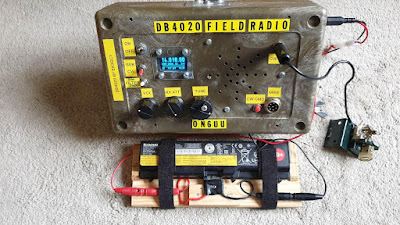Hi,
Recently I got the EA3GCY newsletter, it announced a new kit DB4020, a 2 band transceiver kit covering 40 and 20 mtrs. I know Javier EA3GCY’s kit are good so I ordered one. A week later it arrived in a brown enveloppe in which I found all components and printboard wrapped in bubblewrap, it was all well packed and after checking all components all was accounted for, all components were indeed there.
8 toroids have to be wound, following the instructions it was piece of cake, no problem,
After several hours of work - relax max style - I got everything in place to test, hurray, no smoke !!!! So now the SSB part was ready, I have 7W on 40 and 3.5W on 20mtr. Good power for qrp sota, wff or just garden activity. A fortnight later I got notice that the CW part of the kit was ready and another week later it arrived here, I soldered the 2 boards as soon as possible to get a multimode 2 band transceiver. The 2 boards are the CW interface which also holds the KB-2 keyer, the second board is the 500-600HZ CW filter. The KB-2 give the user 4 memories, beacon function and some more functions. Good thinking to include the keyer, it makes life easy when you’re on an activation. 😊 I opted to make the filter switchable, I like to be able to listen broadband too, very simple, cut one leg of the 13 pin connector on the bottom of the CW interface and put a switch on both ends.

After some figgling around I also got the box ready, a military grade plastic box with wall thickness of 5 mm, this box should be able to withstand a lot of shocks and a drop to the ground. I also made a docking station for a laptop battery which holds some 5Ah and which should be able to give me a lot of hours of listening and some 2 to 3 hours of operation. I had an old laptop which the screen was broken and had some other malfunctions, I have taken the battery connector out of it, luckily I still have another laptop which still works and this is the charging station for the batteries …. .. 😊 The docking is only to test, I will box it up in maybe a some box where I can then maybe also fit a end fed solution or tuner for coax fed antennas.
A new radio also needs a new CW key so I made one out of an old relay, painted the base green to fit somewhat the box et voila, here is the result of the complete portable station.
The key can be fitted to the box by means of a bolt and a wingnut. A short cable goes to the CW connector of the transceiver.
I had a lot of fun constructing this kit, the box, the docking and the key. For 180€ you get a arduino nano controlled CW/SSB transceiver with 2 bands on which most of the activity is and you also get a keyer with memories. Good deal I think. More info is available on EA3GCY’s website. Javier is also very quick in responding to questions, he ask for opinions and offers almost an Elecraft style of service.
I made some video’s which are on youtube :
The kitters website :
Best 73
Frank
ON6UU










































